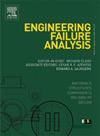瑞利型阶梯袋对分段环形密封泄漏及摩擦学特性影响的实验分析
IF 4.4
2区 工程技术
Q1 ENGINEERING, MECHANICAL
引用次数: 0
摘要
针对航空发动机中应用的分段式环空密封,由于动水压力作用不足导致主密封面磨损导致漏油的问题,设计并加工了瑞利阶梯袋分段式环空密封试件。为研究分段环形密封的泄漏特性和摩擦学特性,搭建了实验平台。对瑞利阶梯口袋分段环形密封(PSAS)和传统分段环形密封(TSAS)的泄漏和摩擦学特性进行了实验研究。结果表明,转速、压差的增大和进口温度的降低会导致泄漏量的增大。在相同条件下,TSAS主密封面表现出典型的磨粒磨损和粘着磨损,而PSAS主密封面仅表现出粘着磨损。瑞利阶梯式密封袋减少了分段环空密封的磨损。转速、压差和进口温度的增大导致分段环空密封的机匣温度升高。在298 K和633 K时,与TSAS相比,PSAS的泄漏量分别平均增加了10.59% ~ 13.44%和9.83% ~ 18.44%,PSAS密封套管温度分别平均降低了11.26% ~ 11.5%和8.45% ~ 8.75%。瑞利泡袋产生的动水压力效应可以增大分段环空密封等效间隙,减少主密封面的磨损,增强空气对分段的对流换热。本文章由计算机程序翻译,如有差异,请以英文原文为准。
Experimental analysis on the influence of Rayleigh stepped pockets on the leakage and tribological characteristics of the segmented annular seal
In response to the problem of oil leakage caused by the wear of the main sealing surface due to the insufficient hydrodynamic pressure effect in the segmented annular seal applied in aero-engines, test pieces of segmented annular seal featuring Rayleigh stepped pockets were designed and processed. An experimental platform was constructed for the purpose of investigating the leakage and tribological characteristics of segmented annular seals. Experimental studies on the leakage and tribological characteristics of Rayleigh stepped pocket segmented annular seal (PSAS) and traditional segmented annular seal (TSAS) were carried out. The results indicate the increase in rotational speed, pressure difference and the decrease in inlet temperature leads to the increase of leakage. When subjected to the same conditions, TSAS main sealing surface displays typical abrasive and adhesive wear patterns, while, PSAS main sealing surface exhibits only adhesive wear. Rayleigh stepped pocket reduces the wear of the segmented annular seal. The increasing rotational speed, pressure difference and inlet temperature lead to the increase of casing temperature of the segmented annular seal. At 298 K and 633 K, compared with TSAS, the leakage of PSAS increases by an average of 10.59 %∼13.44 % and 9.83 %∼18.44 %, respectively, and the temperature of PSAS seal casing decreases by an average of 11.26 % ∼11.5 % and 8.45 % ∼8.75 %, respectively. Hydrodynamic pressure effect generated by the Rayleigh steeped pocket can increase the segmented annular seal equivalent clearance, reduce wear of the main sealing surface, and enhance the air-to-segment convection heat transfer.
求助全文
通过发布文献求助,成功后即可免费获取论文全文。
去求助
来源期刊

Engineering Failure Analysis
工程技术-材料科学:表征与测试
CiteScore
7.70
自引率
20.00%
发文量
956
审稿时长
47 days
期刊介绍:
Engineering Failure Analysis publishes research papers describing the analysis of engineering failures and related studies.
Papers relating to the structure, properties and behaviour of engineering materials are encouraged, particularly those which also involve the detailed application of materials parameters to problems in engineering structures, components and design. In addition to the area of materials engineering, the interacting fields of mechanical, manufacturing, aeronautical, civil, chemical, corrosion and design engineering are considered relevant. Activity should be directed at analysing engineering failures and carrying out research to help reduce the incidences of failures and to extend the operating horizons of engineering materials.
Emphasis is placed on the mechanical properties of materials and their behaviour when influenced by structure, process and environment. Metallic, polymeric, ceramic and natural materials are all included and the application of these materials to real engineering situations should be emphasised. The use of a case-study based approach is also encouraged.
Engineering Failure Analysis provides essential reference material and critical feedback into the design process thereby contributing to the prevention of engineering failures in the future. All submissions will be subject to peer review from leading experts in the field.
 求助内容:
求助内容: 应助结果提醒方式:
应助结果提醒方式:


